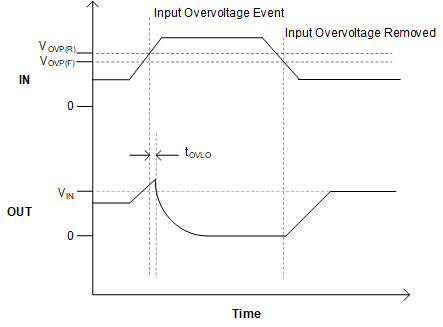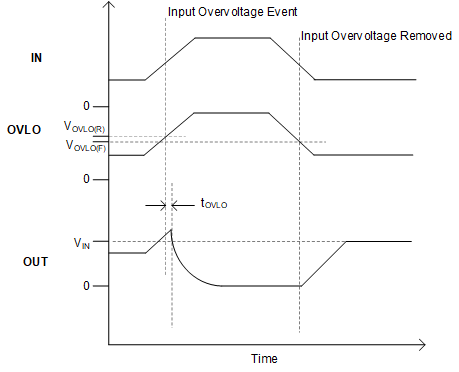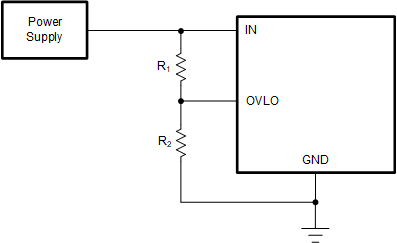ZHCSQ76 December 2022 TPS25961
PRODUCTION DATA
- 1 特性
- 2 应用
- 3 说明
- 4 Revision History
- 5 Pin Configuration and Functions
- 6 Specifications
- 7 Detailed Description
- 8 Application and Implementation
- 9 Device and Documentation Support
- 10Mechanical, Packaging, and Orderable Information
7.3.2 Overvoltage Protection
The TPS25961 implements Overvoltage Protection on VIN in case the applied voltage becomes too high for the system or device to properly operate. The Overvoltage Protection has a default lockout threshold of VOVP, which is achieved by connecting the OVLO pin to GND.
 Figure 7-2 TPS25961 Fixed Overvoltage
Lockout Response
Figure 7-2 TPS25961 Fixed Overvoltage
Lockout ResponseIt’s possible to override the default OVLO threshold and adjust it to an user defined value as per the system requirements. This can be achieved by dividing the input supply and feeding it to the OVLO pin. Whenever the voltage at the OVLO pin rises above a threshold VOVLO(R), the device turns OFF the FET. When the voltage at the OVLO pin falls below the threshold VOVLO(F), the FET is turned ON again. The rising and falling thresholds on this pin are slightly different, thereby providing some hysteresis and ensuring stable operation around the threshold voltage.
 Figure 7-3 TPS25961 Adjustable
Overvoltage Lockout Response
Figure 7-3 TPS25961 Adjustable
Overvoltage Lockout ResponseThe user should choose the resistor divider values appropriately to map the desired input overvoltage level to the OVLO threshold of the part.
 Figure 7-4 TPS25961 Adjustable
Overvoltage Lockout
Figure 7-4 TPS25961 Adjustable
Overvoltage Lockout